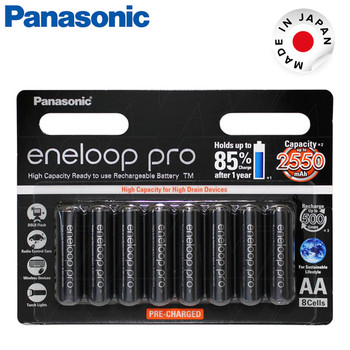Panasonic
Panasonic Eneloop Smart & Quick Battery Charger with 4 x AA Ni-MH Batteries

- SKU:
- PANCHGR-SQ
- UPC:
- 8887549641381
- Shipping:
- Calculated at Checkout
Description

The microprocessor controlled Smart & Quick charger CC16 is perfectly made for the demanding user.
The plug is molded to the case for direct use into an Australian A/C wall socket.
A very special feature is the individual charging, whereas each single cell gets charged on its own.
The charging progress gets checked and ended for each single cell via Peak-Cut-Control.
The charger comes with 4x Eneloop 2000mAh AA Batteries.
Charging control: Smart Charge; delta V ; timer
Indicator: LED × 2 Charging: ON, Full charged: OFF
Charging time: 1.5 - 4 hours
Dimensions: 65 × 105 × 75 mm
Weight: 97 g
Package Includes:
1x Panasonic Eneloop Quick & Smart Battery Charger for AA/AAA batteries K-KJ16MCC4TA
4x BK-3MCCE (AA 2000 mAh) Ni-MH Eneloop rechargeable batteries
Specifications
Input: 100-240V AC, 50/60Hz
Output: 1.5V, 2.2A (AA) | 1.5V 1.1A (AAA)
Battery types: NiMH
AA/AAA batteries: AA (LR6) | AAA (LR03)
Others: Four separate charging channels with LED indicator
Charging time: 1.5 - 4 hours
eneloop is a Ni-MH battery. To understand the modifications done to the eneloop batteries, it helps to understand the construction of a typical Ni-MH battery.
Basic construction of a Ni-MH battery
Ni-MH batteries, like most other rechargeable batteries, consist of two metal stripes - the positive and negative electrode. Between these metal stripes an insulating foil, the separator, is placed. This sandwich of three layers is rolled-up to a coil and placed into a metal can, which acts as negative pole of the battery.
Before closing the can with a cap, a liquid, the electrolyte, is filled into the can. The cap contains a gas release vent, which allows to release hydrogen, when the battery is overcharged. The electrical behaviour of the battery depends on the composition of the electrodes, on the separator and on the used electrolyte.
Modern Ni-MH batteries consist of two metal stripes (anode and cathode), which are separated by a non-conductive porous plastic foil (separator). These three stripes are laid on top of each other and are wound to a coil. This coil is put in a metal can and immersed with a liquid (electrolyte). Then the metal can is closed with a cap.
The self discharge of Ni-MH batteries is caused by three main reasons:
- The chemical decomposition of the cathode
- The natural disaggregation of the anode.
- Impurities of the anode
How could the self-discharge be reduced?
The chemical decomposition of the cathode has been reduced substantially by the use of a new superlattice alloy. As an additional benefit the superlattice alloy increases the electrical capacity of the battery and reduces the internal resistance, which allows higher discharge currents. Another advantage of the super-lattice alloy is that less cobalt is needed to stabilize the compounds' structure.
The anode has been strengthened by another new material, which reduces the natural disaggregation. Additionally the separator and the used electrolyte have been optimised for low self discharge of the eneloop.
Which changes have been made for the new eneloop?
The technological difference between the "old" and the "new" eneloop is, that the super-lattice-alloy of the "new" eneloop has been even more improved.
(1) Advanced materials:
Development of a highly-durable super-lattice alloy.
The durability of Panasonic’s original super-lattice alloy, a negative-electrode material used in eneloop, has been enhanced by homogenizing the crystalline structure (a reduction of crystals with an irregular atomic order is irregular) as well as improving its composition (the ratio of constituent element) to reduce the deterioration of the super-lattice alloy by repeated charge and discharge
(2) Advanced manufacturing method:
Developed technology to protect the surface of the super-lattice alloy
A new additive to the negative electrode material, super-lattice alloy, and a new additive coating technology was developed. By protecting the alloy surface, deterioration of the super-lattice alloy by repeated use can be reduced.
(3) Advanced structure: Use of strong/thin outer case
The new eneloop adopts the same strong/thin outer case used for Panasonic’s industry-leading level high-capacity AA-size rechargeable batteries, the Ni-MH2700 Series. This improves the internal cell space efficiency and optimizes the balance of battery components, leading to an increase in the number of times a battery can be recharged.









